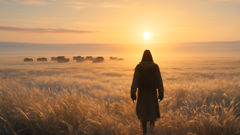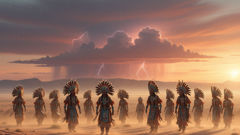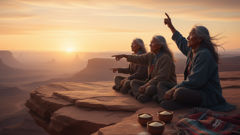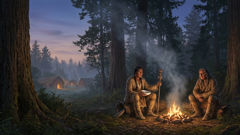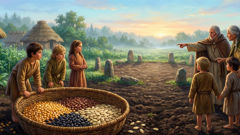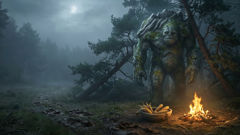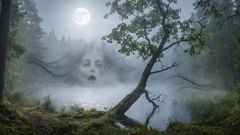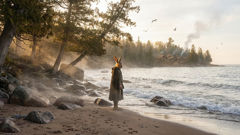Introduction
On the vast windswept plains where the buffalo once moved like living hills, a story begins not with conquest but with a gift. The Lakota tell of the White Buffalo Calf Woman, a figure who arrived between breath and song and spoke in a language older than words. In this retelling, she is not merely a myth to be recited but a living memory that returns whenever a pipe is raised with care, when a child learns to listen to the grass and to the drum, when elders guide hands to share what they have learned with a generous heart. The tale travels from the edge of cedar smoke to river-washed stones, enduring across seasons as a reminder to hold life in balance: to give, to take, and to give again. It is a story about listening—listening to the wind that carries the herds, listening to the cries of the earth, and listening to the quiet voice of responsibility that arrives with ceremony. To meet the White Buffalo Calf Woman is to accept a vow: to walk in harmony with the four directions, to guard the sacred pipe, to honor the children and the elders, and to act with courage when the hunger and hurt of the people need a steady, compassionate hand. This introduction invites you to step softly into a prairie dawn where hoofbeats echo like drums, where the land speaks through scent and stone, and where a visitor in white challenge the heart to remember what it means to live with generosity, humility, and reverence for life.
Section I: The Visitor in the Wind
The plains woke with a soft tremor, and in that tremor a figure walked out of the light, neither fully a woman nor merely a shadow, but something older than either—a being who carried the weather of the people in her eyes. It was said that she came when the earth was hungry for balance, when the people had forgotten how to listen as closely as they spoke. The hunter, unnamed and thoughtful, saw her first as a glimmer among the dry grasses, a human outline made of snow and wind. She spoke with a voice that felt like rain on dry fields, offering no weapon but a pipe carved from cedar and clay, a circle that would become the first breath of ceremony. She asked for nothing but respect: to meet the people with eyes open and hearts steady, to walk in a company that kept the old ways alive without becoming the relics of a memory. As she moved through the dawn, her feet did not trample the grass; they warmed the ground with the certainty of a new path. The wind listened, and the earth listened back, because the White Buffalo Calf Woman had arrived not to conquer but to reconcile. She unveiled her way as a teacher rather than a ruler, asking nothing of the future that humans could not give in the present: to share, to listen, to protect, and to remember. The tribe gathered with a quiet awe, ready to learn the language of the pipe, ready to witness a transformation that would bind people to the land in a pact that would endure beyond generations. In the first hours of this encounter, the form of ceremony began to take shape in the mind of the oldest storytellers, who understood that a single gift could seed a language of gratitude. The visitor spoke of four directions and four seasons, of the vital responsibilities that come with life on this vast floor of wind and water. She asked for a lodge of calm, a heart wide as the horizon, and hands willing to carry what is given with steadiness and humility. When the hunter returned to his kin, he carried not fear but a strange, bright hunger: to learn a new way of being that would ensure the safety of mothers, children, and the herds. And so the first turning of the wheel began, not with triumph, but with listening—the listening that would later be sung in the pipes, danced in the dances, and blessed in the smoke of sacred fires.
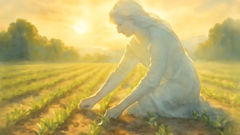
Section II: The Teachings Unfold
In the days that followed, the White Buffalo Calf Woman returned and revealed what the first gift meant—a pipe of cedar, a bowl of sweet medicine, and a set of rituals that would bind people to the land and to one another. She spoke in patient, musical phrases about balance: how a person must tread lightly when the herds are near, how a community must share the meat and the shelter, how a child becomes a keeper of memory by listening to the stories told around the fire. The pipe was not a weapon but a voice, a circle that gathered people into agreement rather than toward division. Smoking the pipe was a vow to speak truth, to tell the whole story even when it hurts, and to listen until a partner in the circle is ready to answer with honesty. She spoke of the four directions—north, south, east, and west—and the seasons that carry their signs. She told of the Sacred Two-Legged and the four-legged, of the birds and the water and the grain, and how every creature has a part to play in the harmony of life. Then came the rituals: the sweat that cleanses the doubt from a body, the drum that keeps the heartbeat of the people steady, the songs that carry the ancestors’ memory forward, and the dances that weave the present into the old and the unborn. The clan gathered to witness, to learn, to try on a new way of behaving—one that asked for endurance yet rewarded with peace. The White Buffalo Calf Woman moved with a grace that felt both ancient and immediate, a reminder that the simplest acts—sharing shelter, offering a seat, speaking truth—could become the bones of a ceremonial life. Through quiet hours and patient instruction, she demonstrated how to honor the four directions by building a home that is strong yet flexible, a people who hold both strength and mercy in balance. The old and the young listened as if for a single, breath-held answer, and in their listening they found not a single command but a field of possible actions that could keep the land fertile and the people free from needless fear.
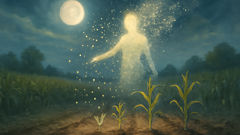
Section III: The Enduring Peace
Time moved with the patience of wind and water, and the people—elders, hunters, artists, and children—began to live the gift in ordinary days. The pipe became a symbol not of possession but of responsibility: to speak kindly when anger flickers, to share what one has, to protect those who cannot defend themselves, and to keep faith with the land that feeds and clothes us. The White Buffalo Calf Woman returned one last time to remind them that peace has many names and many duties. She spoke of the circle that must always include the stranger, the sick, the weak, and the brave who choose restraint over rashness. The ceremonies grew into a living practice—seasonal gatherings, healing rites, child-nurturing rituals, and the quiet prayers of those who walk the furrows of the fields at dawn. The people learned to listen to the wind in the cottonwood trees, to the river’s song, to the echo of old drums in the hills at dusk. And so the world changed—not with a single miracle, but with countless small acts of trust, generosity, and humility. When strangers crossed the plains, they were welcomed; when hardship rose, the people joined hands; when laughter returned, it was shared as the pipe’s breath returning to the circle. The White Buffalo Calf Woman did not remain forever in sight, for a sacred presence never stays long in one place. She stepped back into the light of the prairie, leaving a message etched in the hearts of those who were listening: balance requires courage, mercy, and love of the land. The legend endures not as a museum piece but as a living guide—the wind teaching again, the drum calling, the people answering with acts of care that keep the world in tune with the four directions and the pulse of life.
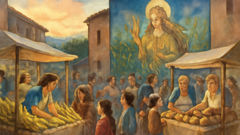
Conclusion
The plains still breathe like a living thing, and the memory of the White Buffalo Calf Woman moves through all who walk there with deference in their step. The gift she offered—not merely a pipe, but a way to listen, to share, and to act with restraint—remains a living instruction. In a world that often moves too quickly, the Lakota memory asks us to pause, to watch the light move across the grass, to hear the drum in the heart, and to choose responsibility over impulse. If you listen, you may hear her footsteps in the morning air, a reminder that harmony is not a destination but a daily vow—kept when we feed the hungry, cradle the vulnerable, guard the four directions, and keep faith with the land that sustains us. The story ends not with triumph over enemies but with the quiet courage of a people who hold ceremony as a living grammar for everyday life, a language of peace that can be spoken by anyone who carries it in their heart.

